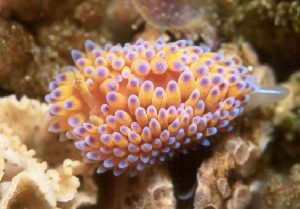
Bonisa nakaza
Gosliner, 1981
Order: NUDIBRANCHIA
Suborder: ARMININA
Family: Zephyrinidae
DISTRIBUTION
Known from the Cape Peninsula [both Atlantic & Pacific coasts] to Port Elizabeth, South Africa.
PHOTO
False Bay, South Africa. Photo: Guido Del Giudice.
The body is broad and roughly oval in outline. The lamellate rhinophores are separated by a slightly wrinkled inter-rhinophoral crest which is triangular in outline, widest anteriorly. The anus opens dorsally in the posterior midline. Quite variable in colour, the body ranges in colour from translucent clear to yellow-orange. The rhinophores have varying amounts of yellow or orange. The cerata show considerable colour variation. Commonly the basal region is yellow with varying amounts of blue towards the tip. Some have a subapical internal concentration of black or dark blue pigment. In other animals, the blue pigment is absent from the cerata, which are translucent white with a yellow or orange tip. Species of Bonisa differ from Janolus in lacking branches of the digestive gland in their cerata. Gosliner (1981) reports that B. nakaza feeds on the heavily calcified bryozoan Tubucellaria levinseni and is found from the shallow sublittoral to 30m in depth. It can grow to 10cm in length.
Reference:
• Gosliner, T.M. (1981) The south African Janolidae (Mollusca, Nudibranchia) with the description of a new genus and two new species. Annals of the South African Museum, 86(1): 1-42.
Rudman, W.B., 2002 (February 1) Bonisa nakaza Gosliner, 1981. [In] Sea Slug Forum. Australian Museum, Sydney. Available from http://www.seaslugforum.net/find/boninaka
Related messages
Janolus capensis or Bonisa nakaza
June 23, 2005
From: Wilhelm van Zyl
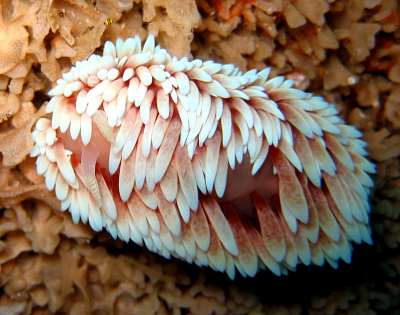
Hi,
I took this picture on Whittle rock in False Bay, near Cape Town, South Africa in about 25m water depth. At first I thought that it was Janolus capensis. But after reading some of the forums I realize that it could also be Bonisa nakaza.
Locality: Whittle Rock, False Bay, near Cape Town, South Africa. Atlantic. Depth: 25 m. Length: 60 cm. Photographer: Wilhelm van Zyl
There was quite a lot of Bonisa on this dive sitting on the same type coral/bryzoans? I have sent photos of 2 specimens of Bonisa nakaza, one regular and one orange variant, all on the same dive and about the same size [see message #14113 ].
Regards
Wilhelm
diving@cyberdale.co.za
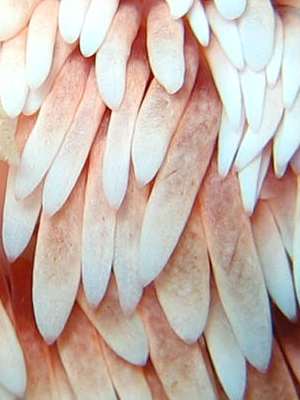
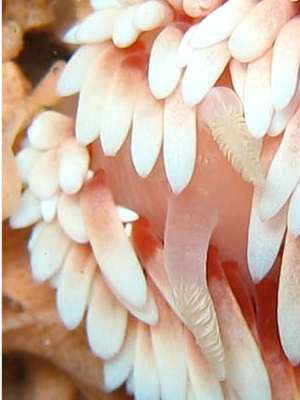
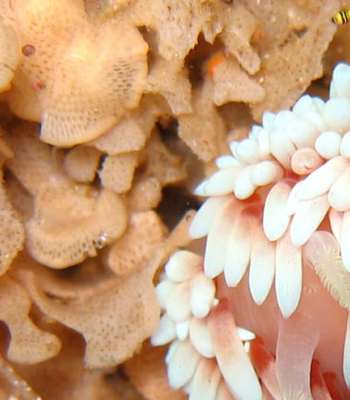
Dear Wilhelm,
I have no personal experience of these species so I am relying on what I can find in publications. As you suggest, at first sight it looks like Janolus capensis, but it could be a colour form of Bonisa nakaza. One major external difference between the two is that Janolus has a large wrinkled ridge (caruncle) between the rhinophores while in Bonisa it is much less prominent. In your photo [see lower right enlargement] there is no sign of the caruncle which I would expect to see even though it is partially obscured. The other major difference is that in Janolus, there is a digestive gland duct in each ceras, while this is absent in Bonisa. I think the reddish-brown colour in the base of the cerata in your photo is the colour of the body fluids rather than an indication of a digestive gland duct. If you look at your separate photo of Janolus capensis [message #14114] you will see the similarly coloured branch of the digestive gland is much narrower, not filling all the space in the ceras. I suspect therefore that your animal is most probably a form of Bonisa nakaza. I would appreciate a comment from Terry Gosliner.
In Terry Gosliner's publication on these animals he identifies the food bryozoans of both these species. Janolus capensis is reported to feed on Menipea triseriata and Onchoporella buskii and Bonisa on Tubucellaria levinseni. I therefore sent your photos to Dennis Gordon, a bryozoologist in New Zealand to see if he could identify the bryozoans, and he sent them on to Wayne Florence, an expert in Sth Africa, who has identified the bryozoan in the photo alongside as a soon to be named new species of Thalamoporella. So when we confirm this animal's identification we have a possible new food identification as well. As I will mention in your separate message [#14113], the typical Bonisa nakaza is on another species of bryozoan.
Best wishes,
Bill Rudman
Bonisa nakaza from False Bay, Sth Africa
June 23, 2005
From: Wilhelm van Zyl
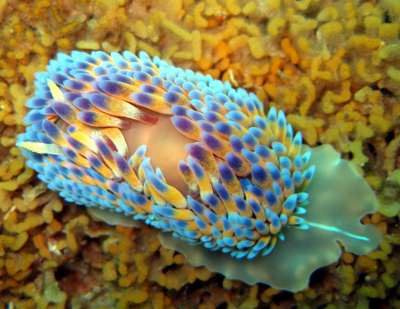
Hi,
To accompany my photo of the nudibranch which looks like Janolus capensis but may be Bonisa nakaza [see message #14092] here are two specimens of Bonisa nakaza, one regular and one orange variant, which I took on the same dive and about the same size.
Locality: Whittle rock, False Bay, near Cape Town, South Africa. Depth: 25 m. Length: 6 cm. Photographer: Wilhelm van Zyl
Regards
Wilhelm
diving@cyberdale.co.za
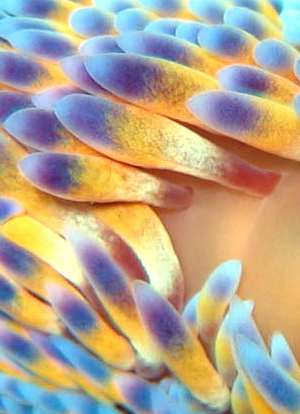
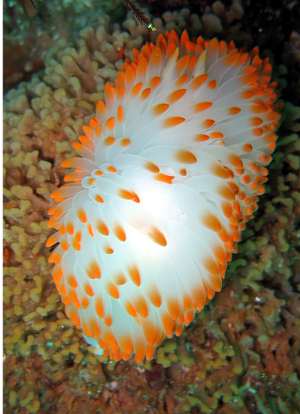
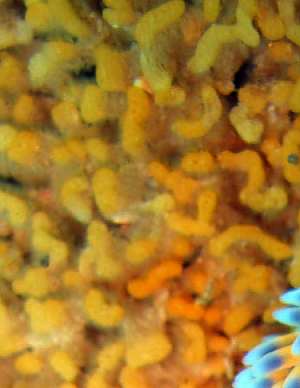
Dear Wilhelm,
Thanks for these. You will se in the close-up of the cerata that there is no digestive gland duct visible in the cerata. This is how the cerata look in your mystery animal [#14092] suggesting it is also Bonisa. As seen in your other message [#14114], the digestive gland ducts are very obvious in Janolus.
It would be interesting to know whether the white line on the 'tail' is always present in this species and absent in Janolus capensis. It might turn out to be a useful distinguishing feature in the field. As I mentioned elsewhere [#14092], Wayne Florence has identified the bryozoan in your photo as Gigantopora polymorpha.
Best wishes,
Bill Rudman
Bonisa and Janolus from S. Africa
March 10, 2004
From: Sakkie du Preez
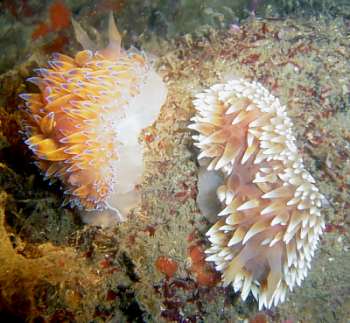
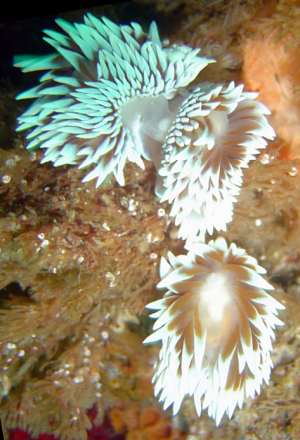
Dear Bill
I have a couple of questions regarding Janolus capensis and Bonisa nakaza that I hope you could help with.
Upper photo:
In October 2003, on a night dive, we found these two huddling together, not that the water was that cold... Anyway, my dive buddy, Annemarie took the photo. We found them on Bell Buoy Reef, Port Elizabeth South Africa, in about 12m of water. Are they both Janolus capensis or is the one with the purple cerata Bonisa nakaza?
Lower photo: And then, eh-hum Dr Rudman, what are the two Janolus capensis up to at the top of the photo? As far as I can see; it looks like the other one is blushing ... I found lots of these parties of 2-4 nudi's on Riy banks at a depth of about 21m. The reef is about 20km out to sea from Port Elizabeth.
Best regards
Sakkie du Preez
Sakkie.DuPreez@comau.co.za
du Preez, S., 2004 (Mar 10) Bonisa and Janolus from S. Africa. [Message in] Sea Slug Forum. Australian Museum, Sydney. Available from http://www.seaslugforum.net/find/12373Dear Sakkie,
Both the animals in the top photo are Bonisa nakasa and those in the bottom one Janolus capensis. I understand that B. nakasa is quite variable in colour but you'll note that in Janolus capensis the white pigment on the cerata covers most of the outer side and only the tip of the inner side while in Bonisa nakasa, the white, if present, only occurs at the tip. More importantly, Janolus has a large inter-rhinophoral crest [caruncle] as you can see in an earlier photo [#11177] and there is no sign of it in the paler animal.
It is also unlikely that you will find them together because they feed on different bryozoans. It is of course possible that you might have a mixed growth of bryozoans, but on the balance of probabilities I think they are both Bonisa. Concerning the lower photo - as you subtly suggest, the upper two animals are mating.
Best wishes
Bill Rudman
Bonisa nakasa from South Africa
August 3, 2003
From: Rudolph van Jaarsveld
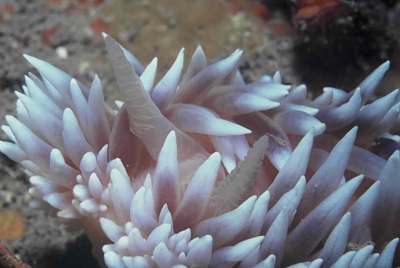
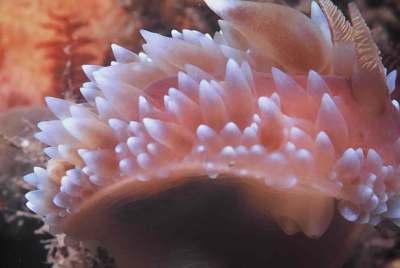
Hi Bill,
Please assist in the identification of the following specimens. Even with the help of Debelius' book I do not have a lot of success.
The photos were taken in 15 meters of water in the bay off Port Elizabeth, South Africa on 18 July 2003. Nikonos V, 1:1 extension tube and 35mm lens.
Regards
Rudolph van Jaarsveld.
rudolph.vanjaarsveld@tcm.co.za
van Jaarsveld, R., 2003 (Aug 3) Bonisa nakasa from South Africa. [Message in] Sea Slug Forum. Australian Museum, Sydney. Available from http://www.seaslugforum.net/find/10559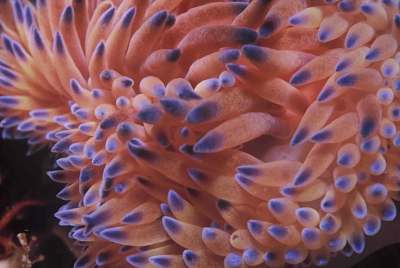
Dear Rudolph,
Certainly the lower photo looks like the animal in one of your earlier messages which I identified as Bonisa nakasa. The upper two photos are more problematic. They could be the same species, or they may be Janolus capensis. Unfortunately I can't see enough detail to be sure. Species of Bonisa differ from Janolus in lacking a branch of the digestive gland up into the cerata on their backs. In colour the lower photo is of Bonisa, but the other two photos could be either, and I can't see clearly through the ceratal wall to determine whether there is any digestive gland htere or not.
Best wishes,
Bill Rudman
Bonisa nakaza - yellow form?
February 7, 2003
From: Rudolph van Jaarsveld
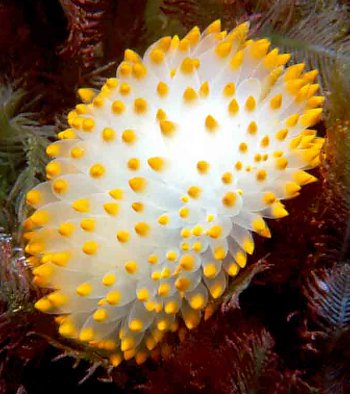
Dear Bill,
Here is another photo taken this year off Simon Town in False Bay, South Africa [January 2003].
Regards.
Rudolph van Jaarsveld
rudolph.vanjaarsveld@tcm.co.za
Jaarsveld, R., 2003 (Feb 7) Bonisa nakaza - yellow form?. [Message in] Sea Slug Forum. Australian Museum, Sydney. Available from http://www.seaslugforum.net/find/9165Dear Rudolph,
In your other message I said we all learn from the identification process and this is a good example. Your other photos were of the yellow and blue form of Bonisa nakaza. I think this photo is also of Bonisa nakaza but a colour form which lacks the blue pigment and has the yellow restricted to the ceratal tips. I have never seen this colour form so I will be interested in having it confirmed by Terry Gosliner, who named this species.
Best wishes,
Bill Rudman
Bonisa nakaza from South Africa
February 7, 2003
From: Rudolph van Jaarsveld
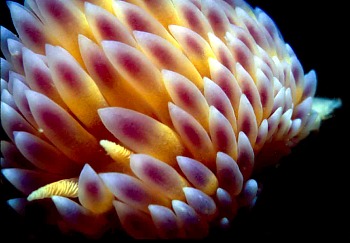
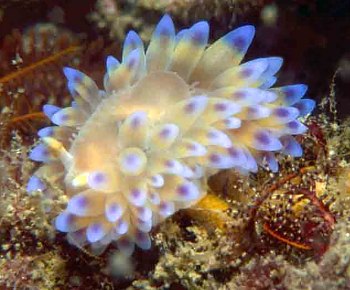
Dear Bill,
Attached please find more photos taken this year off Simon Town in False Bay, South Africa [January 2003]. I am very interested in these small creatures. I would like some guidance in identifying them.
I have tried to use the Sea slug website but because I do not know the scientific names, I battle. Please give me some assistance. What do I do to identify a nudibranch if I only have a picture of it? Thanks very much for the response to my first photo . Knowing more about the animal in my photo means much more than just having the picture.
Regards.
Rudolph van Jaarsveld
rudolph.vanjaarsveld@tcm.co.za
Van Jaarsveld, R., 2003 (Feb 7) Bonisa nakaza from South Africa. [Message in] Sea Slug Forum. Australian Museum, Sydney. Available from http://www.seaslugforum.net/find/9166Dear Rudolph,
These photos are both of Bonisa nakaza, a beautiful species known only from the Cape Region of South Africa. Like all zephyrinid nudibranchs, it feeds on colonial bryozoans.
Concerning difficulties in identifying species on the Forum. I am in the process of adding a couple of keys to the Forum which should help. One will be a simple database query system where you will be able to ask for all the nudibranchs on the Forum with red spots, or all the chromodorids with yellow spots, and you will be rewarded with a page of thumbnail photos to choose from or browse. The other resource will be an interactive 'key' which hopefully will enable you to identify your mystery to any level from species to order.
However, one point of the Forum is to share finds and problems, so I think we would lose if the Forum to become a total 'self-service' identification centre, because we would lose all the new and interesting records that are at present posted for all to share. So don't hesitate to send in your queries - we all learn from the experience.
Best wishes,
Bill Rudman
Bonisa nakaza from South Africa
February 3, 2003
From: Valda Fraser
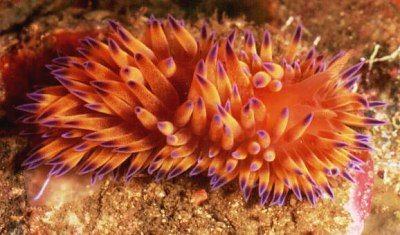
Dear Bill,
This has to be one of my favourites. Do you have any information on its name? In Zulu –'bonisa' means to show, and 'nyakaza' means to move. Maybe there is some link, but I can’t work it out.
Data: Cape St Francis, Eastern Cape, South Africa, 25m. Size: 40mm. Jan 2003.
Regards,
Valda Fraser
valdafraser@mweb.co.za
Fraser, V., 2003 (Feb 3) Bonisa nakaza from South Africa. [Message in] Sea Slug Forum. Australian Museum, Sydney. Available from http://www.seaslugforum.net/find/9058Thanks Valda,
Concerning its name. In Terry Gosliner's description he writes:
Bonisa = ".. is named for my wife Bonnie Isabel ...."
nakaza = ".. is a Zulu word meaning 'to adorn with beautiful colours', and the name is based on the bright coloration typical of this species."
Best wishes,
Bill Rudman
Bonisa nakaza from South Africa
February 2, 2002
From: Erwin Köhler

Dear Bill,
Here is a shot from South Africa, False Bay, by Guido Del Giudice
Email: guidodg@iafrica.com
other data not recorded.
Erwin
Erwin@medslugs.de
Köhler, E., 2002 (Feb 2) Bonisa nakaza from South Africa. [Message in] Sea Slug Forum. Australian Museum, Sydney. Available from http://www.seaslugforum.net/find/6144Dear Erwin,
This is another zephyrinid, Bonisa nakaza. Species of Bonisa differ from species of Janolus in not having branches of the digestive gland extending into the cerata.
Best wishes,
Bill Rudman
